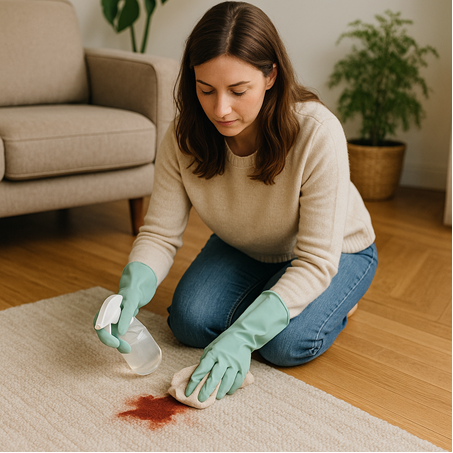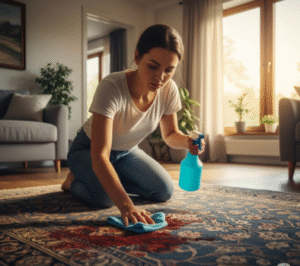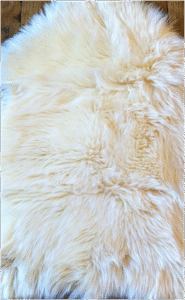Blood stains on area rugs or carpets are surprisingly common. Whether from a small cut, menstrual cycle, food prep mishap, or a pet injury, blood can end up on your rug more easily than you’d think. If not cleaned promptly and correctly, these stains can become permanent. Fortunately, most fresh blood stains are easy to treat with cool water, a bit of dishwashing liquid, and hydrogen peroxide.
But beyond the stain—is blood on rugs dangerous?
The Health Risks of Blood on Rugs
Yes, blood—even when dried—can pose health risks. Blood can carry bloodborne pathogens like Hepatitis B, Hepatitis C, and HIV, which are capable of causing serious infections. Although the risk of infection from dried blood is lower than from fresh blood, some viruses, particularly Hepatitis B, can survive in dried blood at room temperature for days or even weeks.
What Are Bloodborne Pathogens?
Bloodborne pathogens are microorganisms such as viruses and bacteria that are transmitted through contact with infected blood or bodily fluids. According to the American Red Cross, common bloodborne pathogens include:
- Hepatitis B (HBV)
- Hepatitis C (HCV)
- Human Immunodeficiency Virus (HIV)
In some cases, individuals infected with these viruses may show no symptoms, while others might experience fatigue, nausea, jaundice, or more severe symptoms over time.
Can Dried Blood Still Be Infectious?
Yes, in some cases. For example, HBV can remain viable in dried blood for several days. However, the risk of transmission from dried blood is generally much lower than from fresh blood, especially if there’s no direct contact with open wounds or mucous membranes.
Safety and Cleaning Guidelines
To minimize health risks when cleaning up blood stains:
- Wear gloves and, if available, a mask to avoid direct contact.
- Blot, don’t scrub, using cold water and mild detergent first.
- For disinfection, use a solution of hydrogen peroxide or an appropriate disinfectant.
- Dispose of any contaminated cleaning materials properly.
- Always wash your hands thoroughly after cleanup—even if you wore gloves.
Blood on Rugs: Is It Dangerous? And How to Clean It Safely
Blood stains on area rugs or carpets are more common than you might think. Whether it’s from a small cut, menstrual cycle, food prep mishap, or a pet injury—accidents happen. The good news? Fresh blood stains are usually easy to clean if you act quickly. The not-so-good news? Blood can be more than just a cosmetic problem—it can also carry health risks.
Is Blood on Rugs Actually Dangerous?
Yes. Blood, even when it’s dried, can still carry bloodborne pathogens like:
- Hepatitis B (HBV)
- Hepatitis C (HCV)
- HIV
These viruses can cause serious illness, and while transmission from blood on a rug is unlikely, it’s not impossible—especially if there’s direct contact with an open wound or mucous membrane.
Did you know? Hepatitis B can survive in dried blood for several days, even at room temperature.
How to Clean Blood from a Rug Safely
Here’s a simple, safe cleaning method you can use:
You’ll need:
- Disposable gloves
· Cool water
· Dishwashing liquid
· Hydrogen peroxide (3%)
· Clean cloths or paper towels
Steps:
- Wear gloves. Safety first—always protect yourself.
- Blot the stain gently with a cloth soaked in cool water. Avoid hot water—it can set the stain.
- Mix dish soap and cool water and dab the stain again.
- Apply hydrogen peroxide to lift remaining blood. Let it bubble for a minute, then blot.
- Repeat if needed, then pat the area dry.
Dispose of used clothes and gloves properly, and wash your hands thoroughly afterward.
Important Note: Always spot-test cleaning agents on a small, hidden area of the rug first. Certain dyes and fabrics can react unexpectedly. If you have any doubts, contact a professional rug cleaner for guidance.
Bloodborne Pathogen Safety Tips
- Always use personal protective equipment (PPE) when cleaning blood.
- Never scrub aggressively—this spreads the stain.
- Use a disinfectant after cleaning, especially if you’re in a shared space.
- Keep pets and kids away from contaminated areas until fully cleaned.
Tougher Stains? Smart Cleanup Tips That Work
While the steps above are effective for small stains, dealing with larger or older blood spots may require extra care. Timing is critical—the longer blood sits, the more it seeps into fibers and becomes harder to remove. If a stain has dried fully, start by softening it with a damp cloth before applying any cleaning solutions.
For delicate fabrics or valuable rugs, spot testing is a smart move. Even natural solutions like hydrogen peroxide may cause fading in some dyed fibers. Apply your solution to a hidden section first and wait for a few minutes to see if the color remains stable.
When cleaning, work from the outer edge of the stain inward. This prevents the blood from spreading. Use light blotting motions instead of pressing down too hard, which could drive the stain deeper.
Professional Advice Reminder: Some rugs, especially antique or handmade types, require special treatment. If you’re not certain about the material or proper cleaning process, it’s best to consult a professional.
What to Do with Contaminated Items After Cleanup
Used cloths, gloves, and any materials exposed to blood should be handled with care. Seal them in a plastic bag before discarding, and never mix them with food waste or items that children or animals may come into contact with.
In shared environments—such as dormitories, shared apartments, or group homes—inform others about the spill and cleaning process, especially if disinfectants are being used. This helps maintain transparency and safety for everyone in the area.
Simple Ways to Avoid Future Stains
- Although accidents are inevitable, there are steps you can take to prevent blood stains from becoming a recurring problem:
- Keep a small cleaning kit with gloves, dish soap, paper towels, and hydrogen peroxide handy.
- Use protective liners or mats in areas where injuries or spills are more likely to occur, such as near pet beds or craft tables.
- Address injuries quickly, and avoid walking through the house while bleeding—even a small nick on your heel can leave a trail of droplets.
At Rug Journal, we believe prevention is just as important as treatment when it comes to keeping your rugs in top condition. If you want to explore different types, styles, and materials, check out our Rugs Vocabulary section to better understand the rug you’re cleaning.
A Quick Recap: Act Fast, Stay Safe, and Be Smart
Even a tiny blood stain can be more than an inconvenience. Besides the visual blemish, it may harbor pathogens that could lead to health concerns if ignored. With the proper safety measures and cleaning tools, you can address these stains confidently and reduce any potential risks.
Act quickly, follow safe handling practices, and always prioritize personal protection. When it comes to cleaning up blood—speed, caution, and cold water are your best friends.
Disclaimer: The information provided in this article is for general guidance only. Rug Journal does not accept any responsibility for the cleaning, care, or maintenance of your rugs. While we strive to offer helpful tips, we are not liable for any damage, mishandling, or adverse outcomes that may occur. If you are unsure—especially when dealing with biohazards, delicate fibers, or valuable textiles—we strongly recommend consulting a certified professional rug cleaner.





